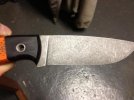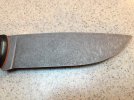- Joined
- Mar 12, 2013
- Messages
- 1,167
Hey all!
I've been thinking lately about trying out some non-directional finishing via tumbling. I like how it looks and I think it's a finish that would work well for my hard use knives.
I've been reading the various threads on bladeforums about other people who've experimented a bit with it, but I haven't found too much info on what setups exactly work for different people.
I've noticed that most of the vibratory tumblers seem to be on the smaller side, and that getting a larger one is going to cost well over $1000. From a size perspective I could do much better with a homebrewed rotary tumbler, but I'm not exactly sure how the finish will differ in appearance. Also not sure whether the finish will look significantly different... I have a small 10-1/4" vibratory tumbler that I'm going to try out once I get some media, but the plan is to go to rotary for the extra capacity.
The setup that I'm contemplating right now is a 12x14" rotary barrel tumbler, with 5/8x3/8" Angle Cut Tri Stars in 'M' grit as my first step, then porcelain burnishing media as my second step. The goal would be to tumble finished knives whole (handles and all), not sure yet whether that will end up working out.
Blades will be taken to 900 grit or so and heat-treated before tumbling unless I'm advised otherwise...
Any and all advice welcomed and appreciated!
I've been thinking lately about trying out some non-directional finishing via tumbling. I like how it looks and I think it's a finish that would work well for my hard use knives.
I've been reading the various threads on bladeforums about other people who've experimented a bit with it, but I haven't found too much info on what setups exactly work for different people.
I've noticed that most of the vibratory tumblers seem to be on the smaller side, and that getting a larger one is going to cost well over $1000. From a size perspective I could do much better with a homebrewed rotary tumbler, but I'm not exactly sure how the finish will differ in appearance. Also not sure whether the finish will look significantly different... I have a small 10-1/4" vibratory tumbler that I'm going to try out once I get some media, but the plan is to go to rotary for the extra capacity.
The setup that I'm contemplating right now is a 12x14" rotary barrel tumbler, with 5/8x3/8" Angle Cut Tri Stars in 'M' grit as my first step, then porcelain burnishing media as my second step. The goal would be to tumble finished knives whole (handles and all), not sure yet whether that will end up working out.
Blades will be taken to 900 grit or so and heat-treated before tumbling unless I'm advised otherwise...
Any and all advice welcomed and appreciated!














